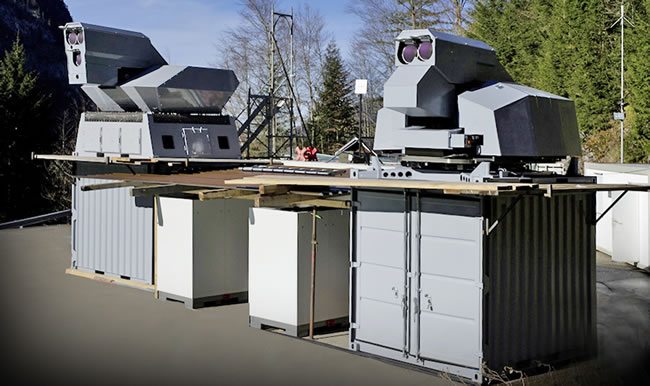High-energy lasers (HEL) have the potential to benefit a variety of military missions, particularly as weapons or as high-bandwidth communications devices. However, the massive size, weight and power requirements (SWaP) of legacy laser systems limit their use on many military platforms.
Even if SWaP limitations can be overcome, turbulence manifested as density fluctuations in the atmosphere increase laser beam size at the target, further limiting laser target irradiance and effectiveness over long distances.
Recently, DARPA’s Excalibur program successfully developed and employed a 21-element optical phased array (OPA) with each array element driven by fiber laser amplifiers. This low power array was used to precisely hit a target 7 kilometers-more than 4 miles away. The OPA used in these experiments consisted of three identical clusters of seven tightly packed fiber lasers, with each cluster only 10 centimeters across.
“The success of this real-world test provides evidence of how far OPA lasers could surpass legacy lasers with conventional optics,” said Joseph Mangano, DARPA program manager.
“It also bolsters arguments for this technology’s scalability and its suitability for high-power testing. DARPA is planning tests over the next three years to demonstrate capabilities at increasing power levels, ultimately up to 100 kilowatts-power levels otherwise difficult to achieve in such a small package.”
In addition to scalability, Excalibur demonstrated near-perfect correction of atmospheric turbulence-at levels well above that possible with conventional optics. While not typically noticeable over short distances, the atmosphere contains turbulent density fluctuations that can increase the divergence and reduce the uniformity of laser beams, leading to diffuse, shifted and splotchy laser endpoints, resulting in less power on the target.
The recent Excalibur demonstration used an ultra-fast optimization algorithm to effectively “freeze” the deeply turbulent atmosphere, and then correcting the resulting static optically aberrated atmosphere in sub-milliseconds to maximize the laser irradiance delivered to the target.
These experiments validated that the OPA could actively correct for even severe atmospheric distortion. The demonstration ran several tens of meters above the ground, where atmospheric effects can be most detrimental for Army, Navy and Marine Corp applications. In addition, these experiments demonstrated that OPAs might be important for correcting for the effects of boundary layer turbulence around aircraft platforms carrying laser systems.
The successful demonstration helps advance Excalibur’s goal of a 100-kilowatt-class laser system in a scalable, ultra-low SWaP OPA configuration compatible with existing weapon system platforms. Continued development and testing of Excalibur fiber optic laser arrays may one day lead to multi-100 kilowatt-class HELs in a package 10 times lighter and more compact than legacy high-power laser systems.
Future tests aim to prove the OPA’s capabilities in even more intense environmental turbulence conditions and at higher powers. Such advances may one day offer improved reliability and performance for applications such as aircraft self-defense and ballistic missile defense.
“With power efficiencies of more than 35 percent and the near-perfect beam quality of fiber laser arrays, these systems can achieve the ultra-low SWaP required for deployment on a broad spectrum of platforms,” said Mangano. “Beyond laser weapons, this technology may also benefit low-power applications such as laser communications and the search for, and identification of, targets.”










